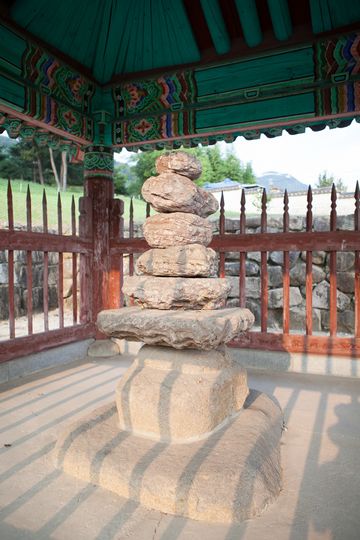"김해 파사석탑"의 두 판 사이의 차이
Mkichukova (토론 | 기여) (→영문) |
Mkichukova (토론 | 기여) (→영문) |
||
| 34번째 줄: | 34번째 줄: | ||
According to the ''Memorabilia of the Three Kingdoms'' (Samguk yusa), Heo Hwang-ok was originally a princess of the faraway Ayuta kingdom (speculated to be in today’s India), but in the year 48, she traveled by boat to Geumgwan Gaya and married King Suro. It is said that she brought this pagoda with her on her boat to balance the strong winds, so it is also called Jinpungtap, meaning "a pagoda balancing the winds". In fact, the stones that this pagoda is composed of, are a type of sandstone, a variety which is not found on the Korean peninsula. | According to the ''Memorabilia of the Three Kingdoms'' (Samguk yusa), Heo Hwang-ok was originally a princess of the faraway Ayuta kingdom (speculated to be in today’s India), but in the year 48, she traveled by boat to Geumgwan Gaya and married King Suro. It is said that she brought this pagoda with her on her boat to balance the strong winds, so it is also called Jinpungtap, meaning "a pagoda balancing the winds". In fact, the stones that this pagoda is composed of, are a type of sandstone, a variety which is not found on the Korean peninsula. | ||
| − | Originally, it was once enshrined at a Buddhist temple named Hogyesa, but it was moved to Tomb of Queen Consort of King Suro in 1873 by the local magistrate Jeong Hyeon-seok who said that it should be placed around Heo Wang-hu*. The pavilion of the pagoda was built in 1992. | + | Originally, it was once enshrined at a Buddhist temple named Hogyesa, but it was moved to Tomb of Queen Consort of King Suro in 1873 by the local magistrate Jeong Hyeon-seok who said that it should be placed around Heo Wang-hu*. The pavilion of the stone pagoda was built in 1992. |
* Heo Wang-hu is another name of Heo Hwang-ok, but I don't know why it was changed in the course of the Korean text, so I left it as it is | * Heo Wang-hu is another name of Heo Hwang-ok, but I don't know why it was changed in the course of the Korean text, so I left it as it is | ||
2022년 12월 1일 (목) 21:03 판
| 김해 파사석탑 |
|
 김해 파사석탑, 국가문화유산포털, 문화재청. |
|
| 대표명칭 | 김해 파사석탑 |
|---|---|
| 한자 | 金海 婆娑石塔 |
| 주소 | 경상남도 김해시 가락로190번길 1 (구산동) |
| 지정번호 | 경상남도 문화재자료 제227호 |
| 지정일 | 1996년 3월 11일 |
| 분류 | 유적건조물/종교신앙/불교/탑 |
| 수량/면적 | 1기 |
| 웹사이트 | 김해 파사석탑, 국가문화유산포털, 문화재청. |
해설문
국문
파사석탑(婆娑石塔)은 삼국유사에 수로왕비 허황옥(許黃玉)이 48년(수로왕 7)에 아유타국에서 바다를 건너올 때 함께 싣고 온 것으로 기록되어 있다. 돌에 희미한 붉은 보랏빛 무늬가 보이는데, 분석결과 한반도에 없는 돌로 밝혀져 삼국유사 기록에 신빙성을 더한다. 바람과 파도를 진정시켜준다는 뜻에서 진풍탑(鎭風塔)으로도 불린다.
1873년 김해부사 정현석이 호계사 자리에 있던 것을 허왕후 곁에 두어야 한다며 수로왕비릉으로 옮겼는데, 1992년 보존을 위해 여기에 옮기고 파사각을 세웠다.
영문
Stone Pagoda, Gimhae
The stone pagoda is said to have been brought from a faraway kingdom called Ayuda in India by Heo Hwang-ok (33-188), the queen consort King Suro (?-199, r. 42-199), who is the founding king of the Geumgwan Gaya state (42-532).
According to the Memorabilia of the Three Kingdoms (Samguk yusa), Heo Hwang-ok was originally a princess of the faraway Ayuta kingdom (speculated to be in today’s India), but in the year 48, she traveled by boat to Geumgwan Gaya and married King Suro. It is said that she brought this pagoda with her on her boat to balance the strong winds, so it is also called Jinpungtap, meaning "a pagoda balancing the winds". In fact, the stones that this pagoda is composed of, are a type of sandstone, a variety which is not found on the Korean peninsula.
Originally, it was once enshrined at a Buddhist temple named Hogyesa, but it was moved to Tomb of Queen Consort of King Suro in 1873 by the local magistrate Jeong Hyeon-seok who said that it should be placed around Heo Wang-hu*. The pavilion of the stone pagoda was built in 1992.
- Heo Wang-hu is another name of Heo Hwang-ok, but I don't know why it was changed in the course of the Korean text, so I left it as it is
영문 해설 내용
파사석탑은 금관가야의 제1대 왕인 수로왕(?-199, 재위 42-199)의 왕비 허황옥(33~188)이 인도 아유타국에서 가져온 것이라고 전해진다. 『삼국유사』에 따르면 허황옥은 인도 아유타의 공주였는데, 48년 배를 타고 와 수로왕의 왕비가 되었다. 거센 풍랑을 진정시키기 위해 배에 이 탑을 함께 싣고 왔다고 하며, “바람을 진정시키는 탑”이라는 뜻의 진풍탑이라고도 불린다. 실제로 이 탑을 이루고 있는 파사석은 사암의 일종인데 한반도에서는 발견되지 않는 종류이다.
원래 호계사라는 사찰에 모셔져 있던 것을 1873년 김해부사 정현석이 허왕후 곁에 두어야 한다며 수로왕비릉으로 옮겼다. 석탑의 보호각은 1992년에 지었다.
참고자료
- 이기환의 흔적의 역사 "한반도엔 없는 돌"…가락국 허황후 '파사석탑의 정체', 경향신문, 2019.12.17. https://www.khan.co.kr/culture/culture-general/article/201912170600001?www